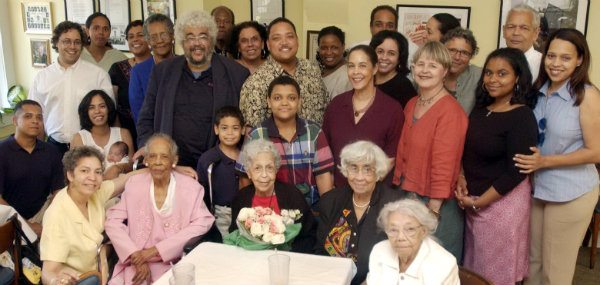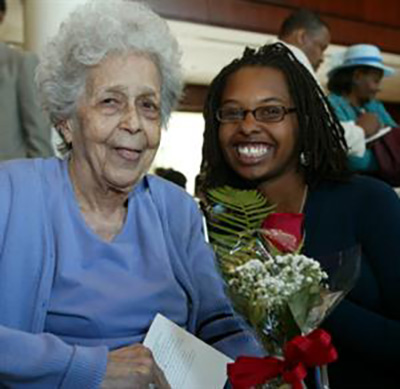SIS Walking Lectures Legacy
Living History Just Beyond the Gates
 Most students is the SIS program had to travel into the city in order to bond with their WOW mentors, but not Mason -- her date with destiny was just a stone's through away. When she exited Spelman's campus through its front gates, she literally faced the building where Julia Bond lived with James, her second son. Like and all of the Bond children, James was an avid reader, and was particularly fond of The New York Times. And like his brother Julian and his sister Jane, C'59, James was an activist. It was James who provided Mason with the photographs archived in SIS. Although he remained in the apartment during the interview, only Mason and Bond journeyed through space and time to the matriarch's memories of Nashville and Pennsylvania and finally to Atlanta on Lee Street, across the street from the College.
Most students is the SIS program had to travel into the city in order to bond with their WOW mentors, but not Mason -- her date with destiny was just a stone's through away. When she exited Spelman's campus through its front gates, she literally faced the building where Julia Bond lived with James, her second son. Like and all of the Bond children, James was an avid reader, and was particularly fond of The New York Times. And like his brother Julian and his sister Jane, C'59, James was an activist. It was James who provided Mason with the photographs archived in SIS. Although he remained in the apartment during the interview, only Mason and Bond journeyed through space and time to the matriarch's memories of Nashville and Pennsylvania and finally to Atlanta on Lee Street, across the street from the College.
"Dr. Gayles, you came to mind when I saw the CNN update about Julian Bond's passing. What a powerful lecture experience it was to travel across the campus to the house in which his mother shared memory stories with the students in SIS... It's so amazing that once the lens of age is opened, it is opened in every facet of life for me now." – Ko Bragg, C’2015.
"Thank you, Dr. Gayles for making us aware of this extraordinary family. Now, I understand why you had us walk at night in the cold to where Mrs. Bond used to live. I will treasure my SIS anthology even more." – Emma Jackson C’2015.
"Like Ko and Emma, I do remember our visit to the Bond home as well as Mrs. Bond's oral narrative, and I thought of these things as soon as I heard of Mr. Julian Bond's death. I was not quite sure what all our journey would entail that night, but it is in times like these I am forever grateful that I followed you without hesitation on that night and always. Constantly, I am realizing that my SIS experiences will not – cannot – escape me." – Jada Holmes, C'2017.
Of the experience, Gloria Wade Gayles, Ph.D., founding director of the SIS Oral History Project and faculty mentor for Spelman's Independent Scholars said, "I was as surprised as the students were when I locked the door to SIS and we began walking in the dark and cold to the two-story red brick building that faces Spelman’s front gate. Once there, we moved from text to place, to culture, to history. More than any other experience, what Ko Bragg called 'the walking lecture' inspired the students to become young scholars of African-American history and culture."
Memories Transcend Time and Place
 "We didn’t live close to other Black children because we lived in a White neighborhood, so it was a matter of children coming to visit. You know, we had to make special arrangements. It wasn’t easy to get to us, but living in the neighborhood had some advantages—you know, like deliveries and getting things that you needed. But it was isolated. It was lonely. We didn’t have any playmates on the block. The children didn’t play with us because we were Black." – Julia Bond as told to Qrescent Mason in 2002.
"We didn’t live close to other Black children because we lived in a White neighborhood, so it was a matter of children coming to visit. You know, we had to make special arrangements. It wasn’t easy to get to us, but living in the neighborhood had some advantages—you know, like deliveries and getting things that you needed. But it was isolated. It was lonely. We didn’t have any playmates on the block. The children didn’t play with us because we were Black." – Julia Bond as told to Qrescent Mason in 2002.
Guided by the elders’ remembering, the students travel to places and experiences that enhance their study of African-American history and culture in the South. They wave at the train that is taking President Roosevelt to Warm Springs, Georgia; they warm their hands in front of a pot-bellied stove in a log-cabin school in the mountains of Tennessee; they wear the metal hat that lights their way through coal mines in Kentucky; they wave at family from a tuberculosis sanitarium in Louisiana; they boil water and wash clothes to assist a midwife in Florida; they pick cotton on a sharecropper’s farm in North Carolina; they witness a lynching in Mississippi; they attend a union meeting in Georgia; and they walk past empty buses in Alabama. From Julia Bond's memory, the students heard stories and learned that Julian Bond became the man whose life we now celebrate because he was birthed by a remarkable woman and reared in a family committed to change.
About Spelman's Independent Scholars Program
In 1991, when she and her sister Sadie were interviewed by a New York Times reporter, Bessie Delaney said, “I never thought anyone would be interested in hearing what two old Negro women have to say.” Spelman students are interested, and that is why they spend two semesters in the SIS Oral History Project. As Young Scholars in the Project, they sit at the feet (sometimes literally) of African-American women elders who have ranged in age from seventy to 107 and in achievement from establishing an orphanage for African-American boys and girls in Atlanta to fighting to save Gullah culture in Sapelo.
The elders’ memories are textbooks that not only give voice and visibility to elders, but also prepare Spelman students from across the disciplines for age-consciousness leadership in the twenty-first century. The SIS Oral History Project is the only learning experience at an institution of higher learning in our nation in which undergraduate women across the disciplines collect memory stories of African-American women elders from small communities or large cities in the American South.
In its race and gender focus, SIS is similar to the Radcliffe College Black Women Oral History Project, considered by some scholars to be the WPA Project for Black women. However, SIS is different from the Radcliffe Project in three significant ways:
- The interviewers for the Radcliffe Project were women across the professions, all of the interviewers in SIS are undergraduate students at a historically Black college;
- The Radcliffe Project was never a course, SIS (Spelman’s Independent Scholars) is a course, the research results of which become archives for the SIS Oral Project; and
- The Radcliffe Project conducted interviews for six significant years of the feminist movement (from 1977 to 1983), SIS will exist in perpetuity.

 As long as there are elders whose stories have not been heard – even by their own family members – students in Spelman's Independent Scholars program will collect the narratives, transcribe the interview tapes, and prepare the harvests for deposit in the SIS-in-LEADS Archives, a gold mine of historical data, shared with tears and with laughter, that have meaning beyond the bonding between elder and student.
As long as there are elders whose stories have not been heard – even by their own family members – students in Spelman's Independent Scholars program will collect the narratives, transcribe the interview tapes, and prepare the harvests for deposit in the SIS-in-LEADS Archives, a gold mine of historical data, shared with tears and with laughter, that have meaning beyond the bonding between elder and student.